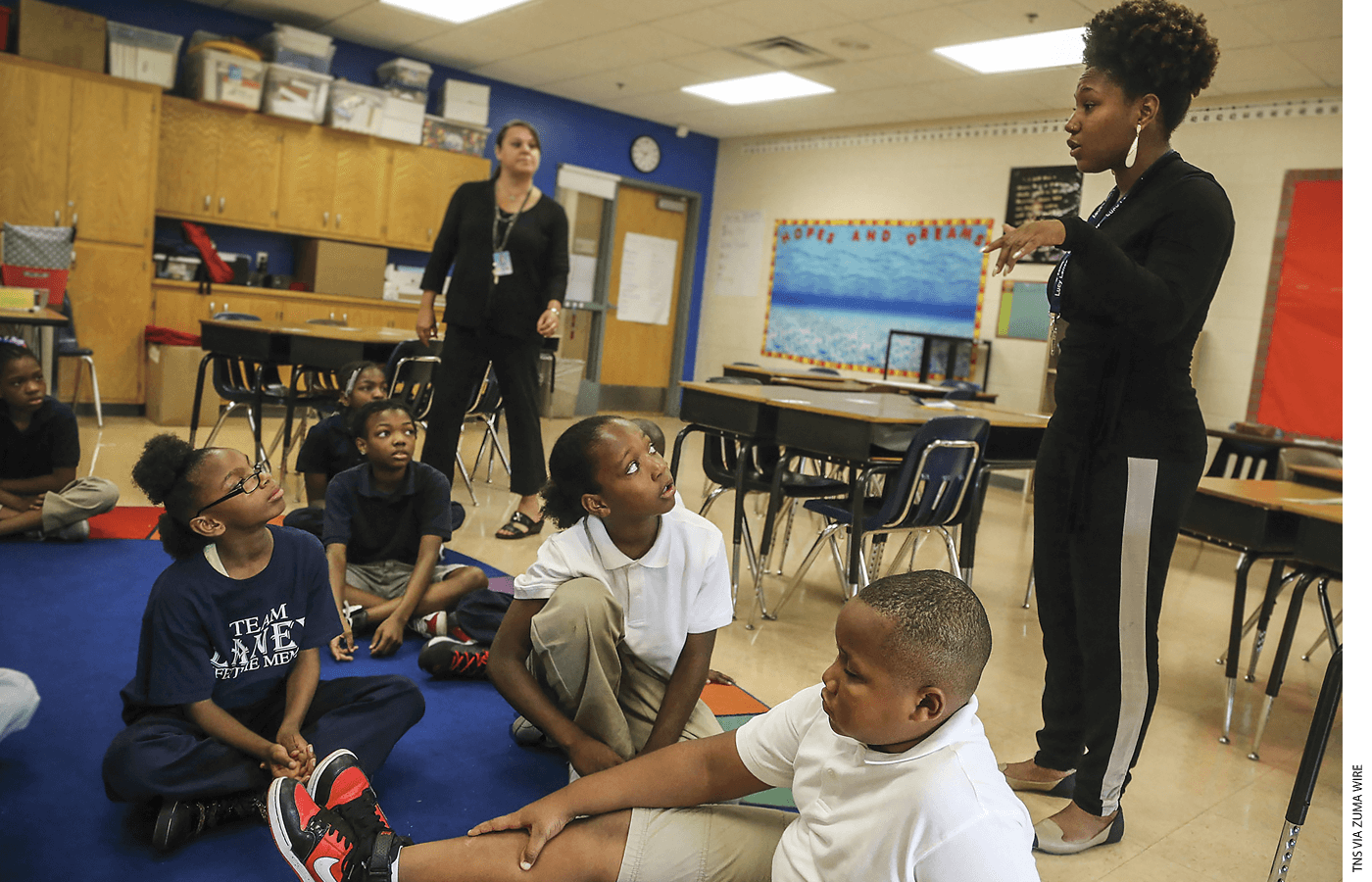
For nearly 50 years, special education law has mandated that students with disabilities be served in the “least restrictive environment” possible. This often takes the form of an inclusive classroom, or a general education classroom where students with disabilities learn alongside their non-disabled peers. In some cases, inclusive classrooms are co-taught by a general education teacher and a special education teacher who share planning and instructional responsibilities.
The logic behind co-teaching is intuitively appealing. Co-teaching reduces the student-teacher ratio, and the presence of two educators, each with distinctive expertise, should make it easier to connect students at a range of abilities to grade-level content. But how well does this approach actually work on the ground? Do students with disabilities benefit from the presence of an additional teacher in the classroom? And how does co-teaching affect learning for students without disabilities?
We examine a decade of test scores for students in Massachusetts, where co-teaching has experienced rapid growth, and find positive effects on academic achievement for students with and without disabilities in the years they are enrolled in co-taught classes. For students with disabilities, attending a co-taught classroom boosts test scores by 2.6 percent of a standard deviation in math and 1.6 percent of a standard deviation in reading, on average. For students without disabilities, test scores improve by 1.2 percent of a standard deviation in math, while reading scores are not affected. This is the case even though students without disabilities who never participate in a co-teaching classroom have higher math and reading scores, on average, than their peers who do.
At the same time, the gains we find are much smaller than those reported in prior research on co-teaching, which involved small samples and focused on short-term results (see “A Charter Boost for Special-Ed Students and English Learners,” research, Spring 2020). By contrast, our analysis looks at co-teaching as it is currently implemented across an entire state, tracks many students over a long period of time, and compares their rates of learning in years they did and did not attend a co-taught classroom.
While co-teaching is broadly popular among educators, its effectiveness for improving student outcomes depends on a key assumption—that the presence of a second adult results in more effective learning opportunities for students. Our findings appear more consistent with studies suggesting that just putting two teachers in the same room does not necessarily improve the quality of instruction students receive. In practice, co-teachers often do not work in the idealized way advocates of the approach recommend. Colocation does not necessarily cause effective collaboration.
Nonetheless, we do find some evidence of positive effects on student learning, even in an apparently less-than-perfect form. Whether the impact of co-teaching at such a scale can be improved by encouraging more consistent application of best practices in co-teaching is an important area for future research.
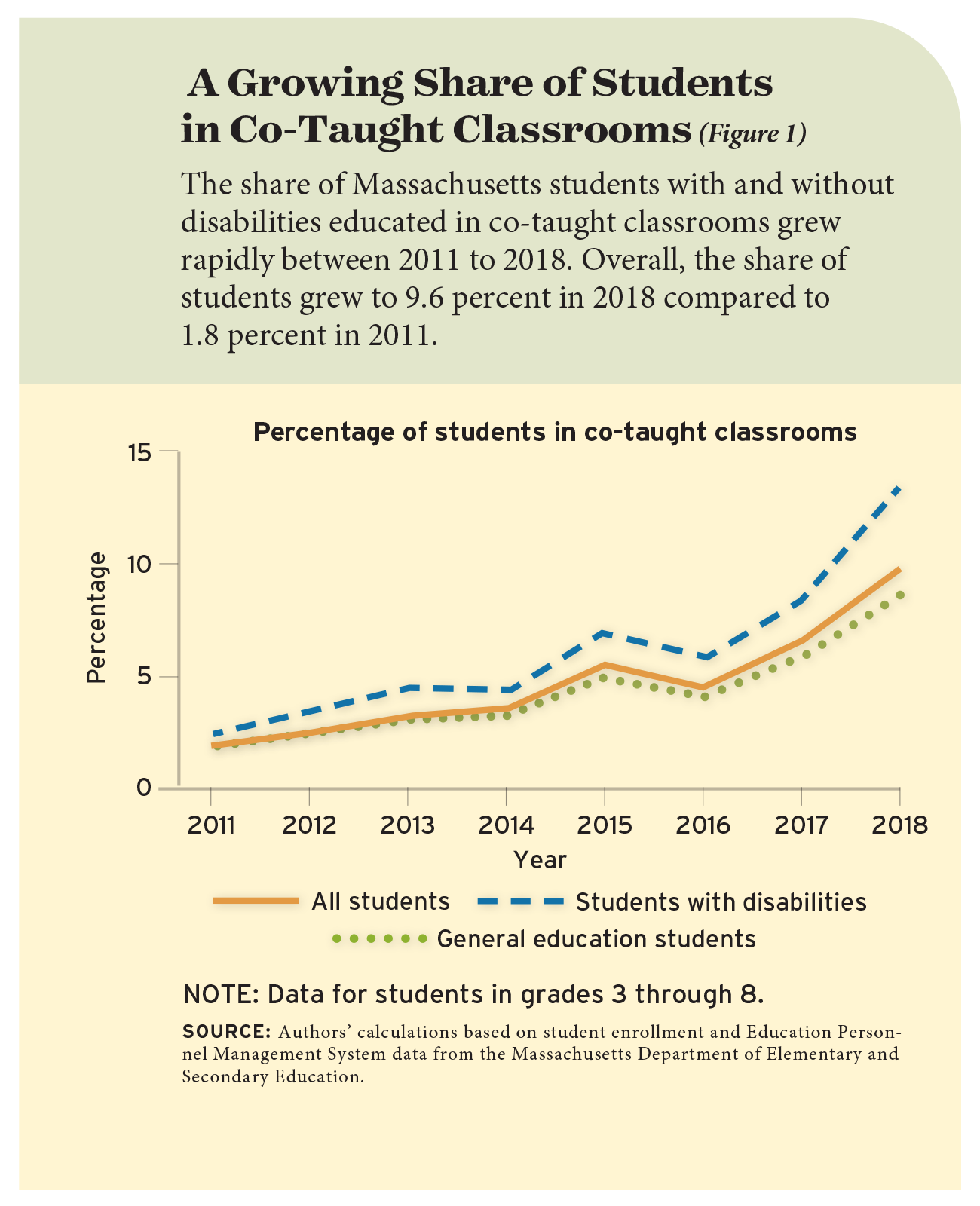
Examining a Team Approach
To investigate the impact of co-teaching on academic achievement, we focus on Massachusetts, where the Department of Elementary and Secondary Education encourages co-teaching but has not adopted it as a statewide initiative. Our analysis uses administrative and test-score data from 2007–08 through 2017–18 for teachers and students enrolled in grades 3 through 8. This includes students’ demographic and socioeconomic data, students’ scores in math and reading on the Massachusetts Comprehensive Assessment System exams, teachers’ job-assignment classifications, and information on classroom assignments that link students with their teachers. We also consider state job-classification data, which identifies a “teacher” as an employee who provides instruction, learning experiences, and care to students during a particular period or in a given discipline and a “co-teacher” as a teacher who is equally responsible with another teacher for providing those same services.
In most cases, schools do not adopt co-teaching as a uniform policy that applies to all students, but rather offer a mixture of co-taught and single-teacher classrooms. We identify classrooms as co-taught based on multiple teachers being assigned to a single class in the same year. In 2011, less than 10 percent of Massachusetts schools educated students with disabilities in co-taught classrooms. By 2018, nearly 30 percent of schools educated at least some students with disabilities in co-taught classes.
The percentage of elementary- and middle-school students educated in co-teaching classrooms has grown sharply in recent years. Between 2011 and 2018, the percentage of all Massachusetts students educated in co-taught classrooms grew to 9.6 percent from 1.8 percent (see Figure 1). That growth was especially sharp in 5th-grade reading, where the percentage of co-taught students increased tenfold. The percentage of 5th-grade students with disabilities educated in co-taught classrooms grew to 26.8 percent from 3.1 percent. Among 5th graders without disabilities, the percentage in co-taught classrooms grew to 19.7 percent from 2.4 percent.
Importantly, most students who enter a co-taught class do not remain in that environment for the rest of their academic careers, but rather switch between co-taught and single-teacher classrooms over time. Because the goal of our study is to understand how attending a co-taught classroom instead of a classroom headed by a single teacher affects a student’s learning, we compare these “sometimes” co-taught students against themselves, both for students with and without disabilities. Our analysis considers whether a student earns higher or lower math and reading scores on state tests in years when they experience co-teaching compared to years when they are in a single-teacher classroom, controlling for characteristics of the student’s school.
Compared to students who never experience a co-taught classroom, students who are sometimes in a co-taught classroom—whether or not they have disabilities—are slightly more likely to be Hispanic, eligible for free or reduced-priced lunch, and have substantially lower math and reading scores, on average. Because decisions about offering co-teaching classrooms are made at the school level, these differences could stem from differences in the characteristics and leadership of schools that adopt co-teaching, as well as from schools’ decisions about which classrooms should use the approach.
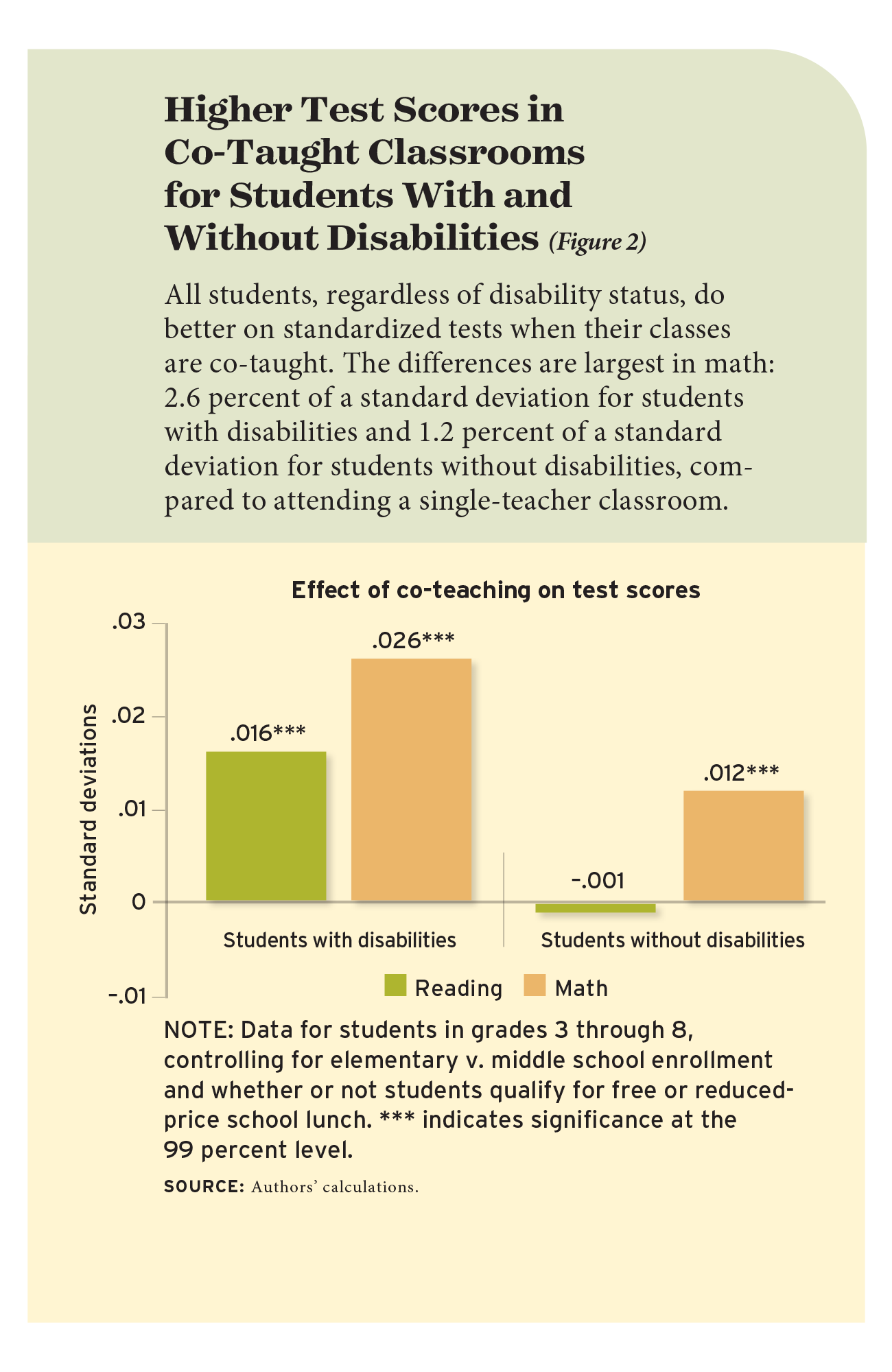
Results
Attending a co-taught classroom improves test scores for students with and without disabilities, especially in math. Test scores for students with disabilities are 2.6 percent of a standard deviation higher in math and 1.6 percent of a standard deviation higher in reading when they are in co-taught classrooms, on average (see Figure 2). The positive impact on math achievement is larger in middle school than in the elementary grades, at 3.6 percent of a standard deviation compared to 1.4 percent in elementary grades. The impact on reading scores does not differ between elementary and middle school.
For students without disabilities, attending a co-taught classroom leads to a significant increase in math scores of 1.2 percent of a standard deviation. We find no significant effect of co-teaching on reading scores for students without disabilities. In looking separately at elementary- and middle-school grades, attending a co-taught classroom improves reading scores by 0.4 percent of a standard deviation in elementary school and reduces scores by 0.6 percent of a standard deviation in middle-school grades. However, these results are not statistically significant.
We also examine our results based on the characteristics of students in a class, including the percentage of students with disabilities in the class, and find little impact on the estimated effects of co-teaching. The estimated effect on reading in middle-school grades appears larger for females with disabilities at 2.8 percent of a standard deviation compared to 0.6 percent of a standard deviation for males with disabilities. We also find that the impact on reading scores in elementary grades is larger for Black students with disabilities compared to white students with disabilities, at 5.1 percent of a standard deviation versus 0.7 percent, respectively. However, neither of these differences is statistically significant. In looking across disability categories, we find positive effects from co-teaching within each disability type (see Figure 3).
We also look at the test scores for students with disabilities in co-taught classes compared to those for students in two types of single-teacher classes: special education and general education. We consider classes specific to special education if they are led by a special education teacher and predominately enroll students with disabilities. In no case do we find a significant difference between the effect of attending a special education versus a general education class with a single teacher. We interpret this as evidence that the effect of a student with disabilities attending a co-taught classroom is similar regardless of whether the student would otherwise be “mainstreamed” in a general education classroom without a co-teacher or enrolled in a self-contained special education class.
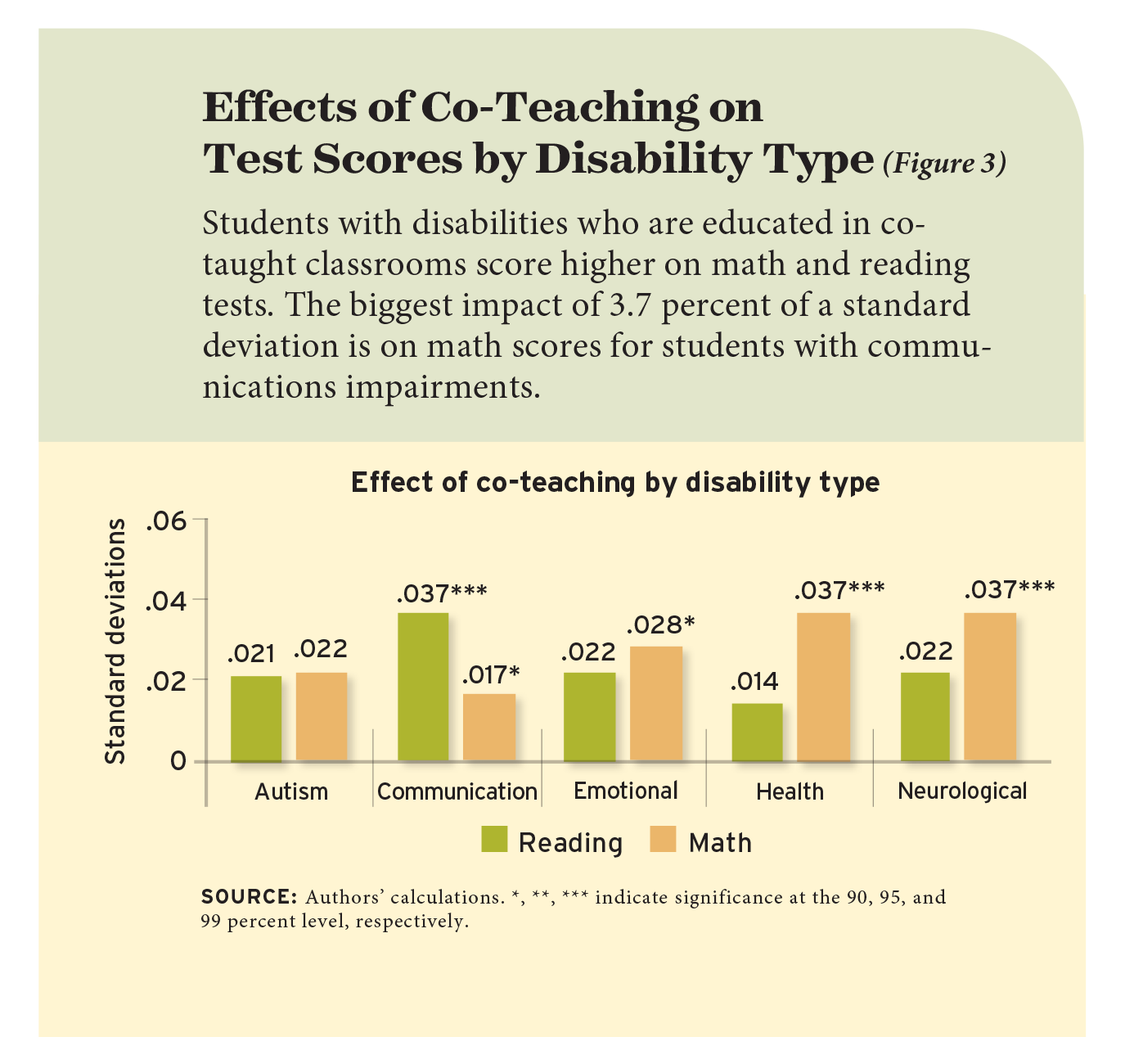
More Than the Sum of Its Parts
We find that co-teaching has positive effects on academic achievement for students with and without disabilities, but the size of the impact on students with disabilities is substantially smaller than those reported in prior studies. Our results show that co-teaching can produce some benefits when implemented at scale, but they do not appear consistent with the enthusiasm that surrounds the practice in special education literature.
However, our analysis is limited to the effect of co-teaching on student test scores. Some of the most important justifications for moving students with disabilities into inclusive general education classrooms, which co-teaching can facilitate, are not academic. Inclusive environments like co-taught classrooms can foster tolerance and understanding among typically developing students, while also supporting students with disabilities to practice and develop social skills and build friendships with a broad group of peers.
That we analyze co-teaching within the context of a large public-school system is arguably both our study’s most valuable contribution and its most substantial limitation. Proponents of co-teaching might reasonably argue that the magnitude of our estimates is muted by schools and teachers that have moved students into classrooms where teachers are purportedly co-teaching but, in reality, do not apply the best practices necessary for co-teaching to be effective. Indeed, differences in the fidelity of implementation when co-teaching is considered across an entire state rather than within the context of a single school or classroom could at least partially explain why our findings are so much smaller than prior estimates. It is also primarily for this reason that, though co-teaching certainly reduces the adult-to-student ratio within a classroom, we caution against interpreting our results for the effect of co-teaching as the effect of substantially reducing class size.
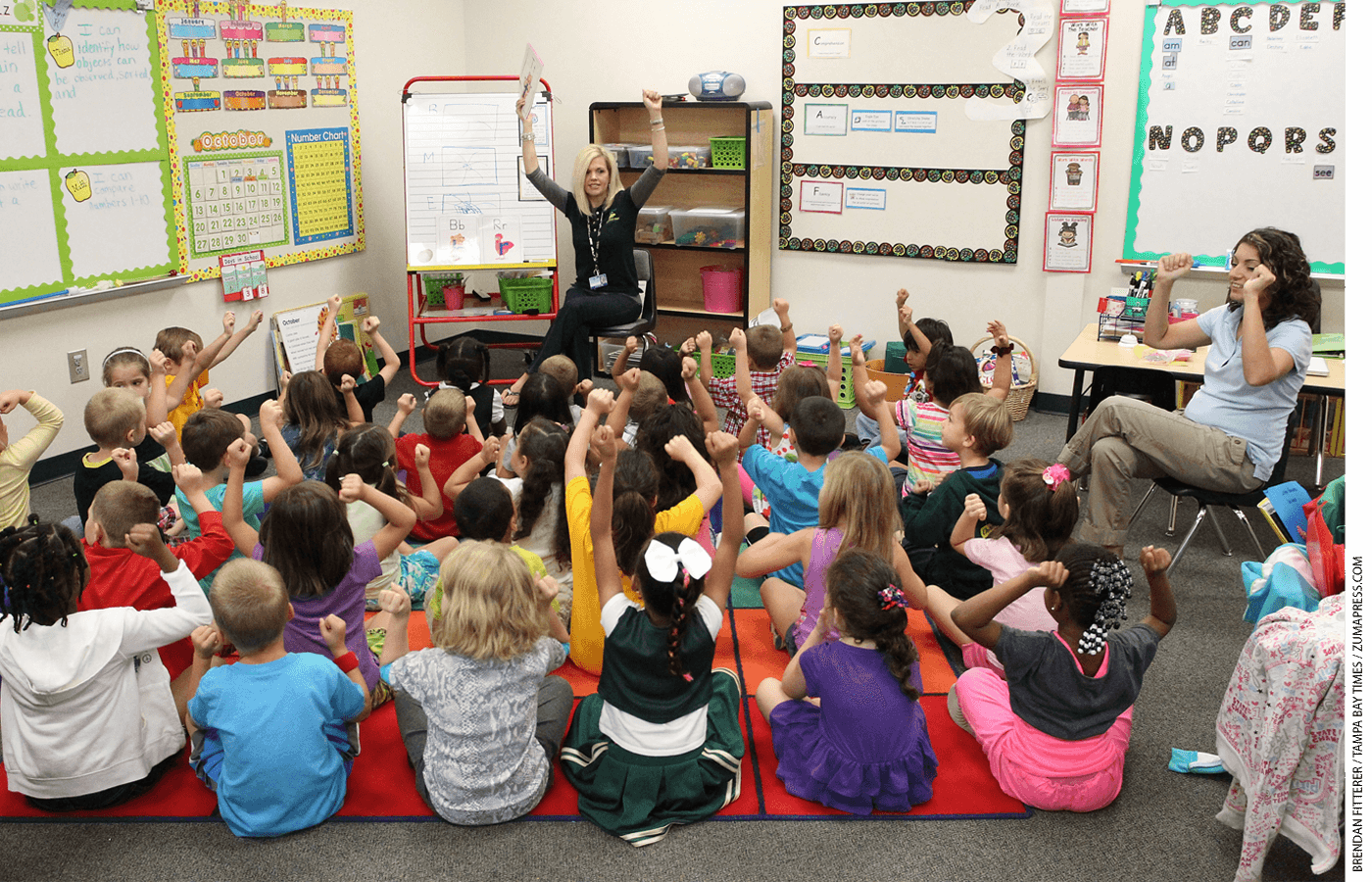
From a policy perspective, whether our findings support a decision to adopt co-teaching as an instructional model depends on the associated costs, which are thus far unknown. Transitioning to a co-teaching model almost certainly would require additional resources and personnel, which would appear to be a costly proposition. However, if considered within the broader topic of special education spending, using co-teaching to create inclusive general education classrooms may prove to be an efficient model. Prior research has found that serving students with disabilities in inclusive general education settings with team teaching costs less than sending students to standalone programs or classrooms.
School leaders and policymakers may consider whether the relevant comparison is between single-teacher and co-taught class costs, or between inclusive and non-inclusive special education programs. We encourage the field to continue building a more robust evidence base surrounding the services schools provide to the especially vulnerable group of students with disabilities.
Nathan Jones and Marcus A. Winters are associate professors at Boston University.
This article appeared in the Winter 2023 issue of Education Next. Suggested citation format:
Jones, N., and Winters, M.A. (2023). Are Two Teachers Better Than One? The effect of co-teaching on students with and without disabilities. Education Next, 23(1), 54-59.


